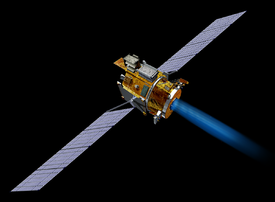Deep Space 1

Artist concept of Deep Space 1
|
|||||||||
| Mission type | Technology demonstrator | ||||||||
|---|---|---|---|---|---|---|---|---|---|
| Operator | NASA / JPL | ||||||||
| COSPAR ID | 1998-061A | ||||||||
| SATCAT no. | 25508 | ||||||||
| Website | http://www.jpl.nasa.gov/missions/deep-space-1-ds1/ | ||||||||
| Mission duration | Final: 3 years, 1 month, 24 days | ||||||||
| Spacecraft properties | |||||||||
| Manufacturer | Orbital Sciences Corporation | ||||||||
| Launch mass | 486 kg (1,071 lb) | ||||||||
| Dry mass | 373 kg (822 lb) | ||||||||
| Dimensions | 2.1 × 11.8 × 2.5 m (6.9 × 38.6 × 8.2 ft) | ||||||||
| Power | 2,500 watts | ||||||||
| Start of mission | |||||||||
| Launch date | 24 October 1998, 12:08 UTC | ||||||||
| Rocket | Delta II 7326 | ||||||||
| Launch site | Cape Canaveral SLC-17A | ||||||||
| End of mission | |||||||||
| Disposal | Decommissioned | ||||||||
| Deactivated | 18 December 2001, 20:00 UTC | ||||||||
| Flyby of 9969 Braille | |||||||||
| Closest approach | 29 July 1999, 04:46 UTC | ||||||||
| Distance | 26 km (16 mi) | ||||||||
| Flyby of 19P/Borrelly | |||||||||
| Closest approach | 22 September 2001, 22:29:33 UTC | ||||||||
| Distance | 2,171 km (1,349 mi) | ||||||||
|
|||||||||
 DS1 mission logo |
|||||||||
| Instruments | |
|---|---|
| MICAS | Miniature Integrated Camera-Spectrometer |
| PEPE | Plasma Experiment for Planetary Exploration |
| IDS | Ion Propulsion System (IPS) Diagnostic Subsystem |
Deep Space 1 (DS1) was a NASA technology demonstration spacecraft which flew by an asteroid and a comet. It was part of the New Millennium Program, dedicated to testing advanced technologies.
Launched on 24 October 1998, the Deep Space 1 spacecraft carried out a flyby of asteroid 9969 Braille, which was its primary science target. The mission was extended twice to include an encounter with comet 19P/Borrelly and further engineering testing. Problems during its initial stages and with its star tracker led to repeated changes in mission configuration. While the flyby of the asteroid was a partial success, the encounter with the comet retrieved valuable information. Three of twelve technologies on board had to work within a few minutes of separation from the carrier rocket for the mission to continue.
The Deep Space series was continued by the Deep Space 2 probes, which were launched in January 1999 piggybacked on the Mars Polar Lander and were intended to strike the surface of Mars (though contact was lost and the mission failed). Deep Space 1 was the first NASA spacecraft to use ion propulsion rather than the traditional chemical-powered rockets.
The purpose of Deep Space 1 was technology development and validation for future missions; 12 technologies were tested:
The Autonav system, developed by NASA's Jet Propulsion Laboratory, takes images of known bright asteroids. The asteroids in the inner Solar System move in relation to other bodies at a noticeable, predictable speed. Thus a spacecraft can determine its relative position by tracking such asteroids across the star background, which appears fixed over such timescales. Two or more asteroids let the spacecraft triangulate its position; two or more positions in time let the spacecraft determine its trajectory. Existing spacecraft are tracked by their interactions with the transmitters of the NASA Deep Space Network (DSN), in effect an inverse GPS. However, DSN tracking requires many skilled operators, and the DSN is overburdened by its use as a communications network. The use of Autonav reduces mission cost and DSN demands.
...
Wikipedia
